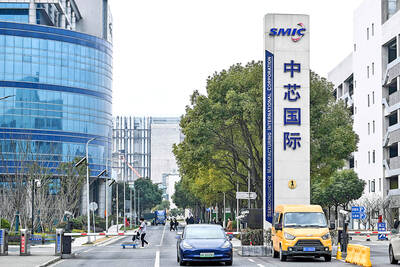The global DRAM industry next year is expected to enter a new downcycle, with chip prices likely to decline 15 to 20 percent annually amid a supply glut, market researcher TrendForce Corp (集邦科技) said yesterday.
Major memorychip makers have conservatively expanded capacity — with the overall DRAM supply next year likely to grow 17.9 percent annually — but the growth in supply would still exceed an expected 16.3 percent growth in demand, given lackluster orders for products, especially smartphones, TrendForce said.
While demand for server DRAM chips is expected to rise 20 percent next year and demand for PC DRAM chips to rise more than 15 percent, demand for mobile DRAM chips could be as low as 15 percent — making it weaker than expected — after smartphone shipments only rise 3.5 percent to 1.4 billion units next year, TrendForce said.
Smartphones use 40 percent of the DRAM chips produced each year, but shortages of processors, driver ICs and other key components could cap their growth next year, it said.
Given such constraints, the world’s DRAM industry is projected to see flat growth next year, with overall revenue edging up only 0.3 percent from an estimated US$90 billion for this year, it added.
Based on TrendForce’s research, Samsung Electronics Co, the world’s biggest memorychip maker, is expected to increase its chip output by 19.6 percent next year by upgrading the technology on the production line at its Pyeongtaek campus.
SK Hynix Inc is to expand capacity by 17.7 percent by migrating to 1y-nanometer and 1z-nanometer technologies, while Micron Technology Inc is to boost capacity by 16.3 percent, TrendForce said.
In Taiwan, Nanya Technology Corp (南亞科技) and Winbond Electronics Corp (華邦電子) are to expand capacity a negligible amount, as Nanya’s new fab is to enter volume production in 2024 and Winbond’s new fab is to begin trial operations next year, it said.

SEMICONDUCTOR SERVICES: A company executive said that Taiwanese firms must think about how to participate in global supply chains and lift their competitiveness Taiwan Semiconductor Manufacturing Co (TSMC, 台積電) yesterday said it expects to launch its first multifunctional service center in Pingtung County in the middle of 2027, in a bid to foster a resilient high-tech facility construction ecosystem. TSMC broached the idea of creating a center two or three years ago when it started building new manufacturing capacity in the US and Japan, the company said. The center, dubbed an “ecosystem park,” would assist local manufacturing facility construction partners to upgrade their capabilities and secure more deals from other global chipmakers such as Intel Corp, Micron Technology Inc and Infineon Technologies AG, TSMC said. It

People walk past advertising for a Syensqo chip at the Semicon Taiwan exhibition in Taipei yesterday.

NO BREAKTHROUGH? More substantial ‘deliverables,’ such as tariff reductions, would likely be saved for a meeting between Trump and Xi later this year, a trade expert said China launched two probes targeting the US semiconductor sector on Saturday ahead of talks between the two nations in Spain this week on trade, national security and the ownership of social media platform TikTok. China’s Ministry of Commerce announced an anti-dumping investigation into certain analog integrated circuits (ICs) imported from the US. The investigation is to target some commodity interface ICs and gate driver ICs, which are commonly made by US companies such as Texas Instruments Inc and ON Semiconductor Corp. The ministry also announced an anti-discrimination probe into US measures against China’s chip sector. US measures such as export curbs and tariffs

The US on Friday penalized two Chinese firms that acquired US chipmaking equipment for China’s top chipmaker, Semiconductor Manufacturing International Corp (SMIC, 中芯國際), including them among 32 entities that were added to the US Department of Commerce’s restricted trade list, a US government posting showed. Twenty-three of the 32 are in China. GMC Semiconductor Technology (Wuxi) Co (吉姆西半導體科技) and Jicun Semiconductor Technology (Shanghai) Co (吉存半導體科技) were placed on the list, formally known as the Entity List, for acquiring equipment for SMIC Northern Integrated Circuit Manufacturing (Beijing) Corp (中芯北方積體電路) and Semiconductor Manufacturing International (Beijing) Corp (中芯北京), the US Federal Register posting said. The